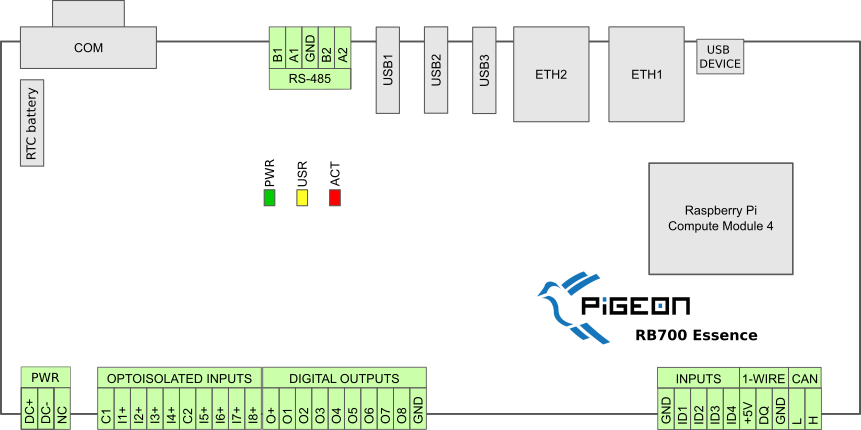Pigeon RB700 is a computer designed for use in industrial control and automation systems. Pigeon RB700 is powered by Raspberry Pi Compute Module 4 and Linux system. RB700 model is available in three versions: ESSENCE, STANDARD and ADVANCE. The versions differ in the number of available interfaces. The ESSENCE version is the simplest and does not have UPS, HDMI, analog I/O and TPM compared to the STANDARD version. All versions have the following interfaces: two RS-485, two Ethernet, CAN, 1-WIRE, RS-232, 12 digital inputs (8 opto-isolated, 4 dry contact) and 8 digital outputs.
Powered by Raspberry Pi Compute Module 4
Broadcom BCM2711 quad-core
ARM Cortex-A72 64-bit SoC 1.5GHz
1GB SDRAM LPDDR4 (optionally up to 8GB)
8GB eMMC Flash (optionally up to 32GB)
Rich set of interfaces
2 x USB 2.0
3 x RS-232
2 x RS-485
2 x Ethernet
CAN FD
1-Wire
A lot of inputs and outputs
8 x digital opto-isolated inputs
4 x dry contact inputs
8 x open drain outputs
Real Time Clock
Real Time Clock with battery backup
Robust design
Meets requirements of EN IEC 61326-1:2021 for basic and industrial electromagnetic environments
Two watchdogs
Created for long life
Designed, developed and produced in European Union
No electrolytic capacitors
No moving parts
Low power consumption
High-efficiency DC/DC converters
Peripherals power supply control
Linux on board
Small and stable distribution that is fully compatible with official Raspberry Pi OS
Full support for all interfaces
Large community
Easy programmable
Installed Linux supports almost all of the major programming languages (C/C++, Python, , Java, etc.)
Open source and commercial software for automation and control systems
DIN rail enclosure
DIN rail enclosure with the optional wall mount


Comments are closed.